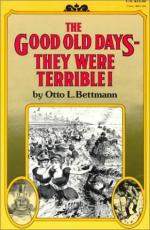|
This section contains 405 words (approx. 2 pages at 400 words per page) |

|
Chapter 5, Work Summary and Analysis
Absent of any labor laws, the wedge between the rich and the poor was huge during the last half of the 19th century. By 1890 as few as one percent of the American population owned as much as the remaining 99 percent put together. Labor was treated as a commodity to be used up and replaced.
Many industrial jobs featured toxic inhalants the workers had to endure, including sawdust, coal dust, chemicals, and stone dust. Workers were kept on a demonic pace in a seven-day workweek. Many developed health problems and could not work past the age of forty.
Accidents were frequent, and largely ignored. The railroad industry and steel mills were the most dangerous places to work. In 1890, for example, one out of every 306 employed railroaders died from a work-related injury. There was no such concept as workman's compensation or...
(read more from the Chapter 5, Work Summary)
|
This section contains 405 words (approx. 2 pages at 400 words per page) |

|




